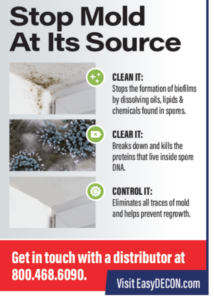 Molds are types of fungi that may grow indoors or outdoors, usually in warm, damp and humid environments. There are many kinds of mold, some of which are benign and of no concern to the homeowner. Others, however, can pose sometimes grave health hazards and may even cause structural damage to the home. Many people don?t realize they have a mold problem because they don?t know what to look for. Here are some clues that your home may be harboring harmful mold, according to the CDC and the EPA.
Molds are types of fungi that may grow indoors or outdoors, usually in warm, damp and humid environments. There are many kinds of mold, some of which are benign and of no concern to the homeowner. Others, however, can pose sometimes grave health hazards and may even cause structural damage to the home. Many people don?t realize they have a mold problem because they don?t know what to look for. Here are some clues that your home may be harboring harmful mold, according to the CDC and the EPA.
- Your seasonal allergies never go away, or lessen when you leave your home;
- Your asthma gets worse for no obvious reason;
- You feel like you have a cold that won?t go away;
- You have chronic fatigue;
- Your wallpaper is pealing, or your walls are bubbly;
- Your air conditioner or heating smells strangely;
- You see dark or colored spots on your walls;
- There?s a musty odor in the home;
- You use a humidifier;
- You live in a new home that is tightly sealed; or
- Your home has experienced flooding or water damage.
In order to grow, mold needs moisture, it is normally found in areas that are damp and humid. Common spots for mold growth are:
- Behind any drywall that has been subjected to flooding or plumbing leaks;
- Under carpeting that was wet at one time, either from flooding or cleaning;
- Beneath stacks of paper such as newspaper or cardboard;
- In ventilation ducts;
- Behind the wallboard around leaking windows;
- Below sinks; and
- Behind your refrigerator.
While there are thousands of species of mold, most homeowners are rightfully concerned about Stachybotrys Chartarum, or black mold. Although rare, it produces a high level of mycotoxins that can create a hazardous home environment. Mycotoxins are chemical compounds that can attach to mold spores and drift through the air looking for a new home. When inhaled, mycotoxins can cause serious health issues. To detect black mold, follow your nose. They exude a musty, earthy smell similar to dirt and rotting leaves. These spores like to live in wet as opposed to moist environments and feed on wet cellulose-based materials such as cloth, wicker, drywall and cardboard.
Once mold is discovered or suspected, you should contact a certified mold removal professional who uses EasyDECON DF200.? It is important to remove mold as soon as possible in order to mitigate its growth.
Contact Intelagard to learn more about EasyDECON? DF200 for your mold remediation project.

